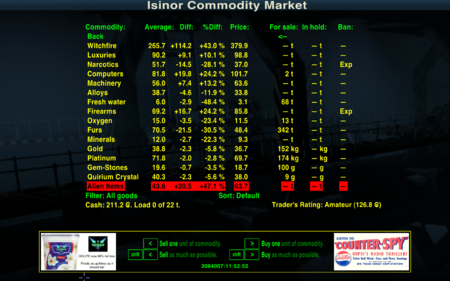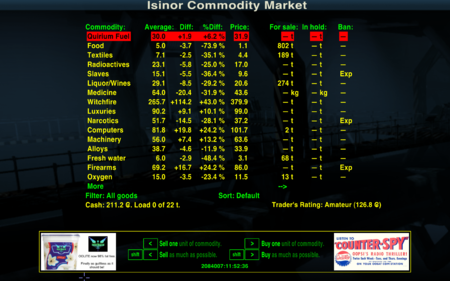Difference between revisions of "Real-Life Economics"
Cholmondely (talk | contribs) m (→Gameplay and Balance Indicator: Oops!) |
Cholmondely (talk | contribs) m (Tagged as demo-OXP) |
||
| (5 intermediate revisions by the same user not shown) | |||
| Line 7: | Line 7: | ||
The markets in Oolite are based on the original 8-bit [[Classic Elite]]. Of the various attempts to modify the markets and improve on them, this one, in my opinion is the best. It scraps the 8-bit limits on market quantities (127 units of everything) as far as was possible in 2014, and replaces the simplistic static markets with more realistic dynamic markets. |
The markets in Oolite are based on the original 8-bit [[Classic Elite]]. Of the various attempts to modify the markets and improve on them, this one, in my opinion is the best. It scraps the 8-bit limits on market quantities (127 units of everything) as far as was possible in 2014, and replaces the simplistic static markets with more realistic dynamic markets. |
||
| − | If he was rewriting it now, I'm sure he could improve it even more. But it is still ''brilliant''! Try it and see! ''Cholmondeley 17:02, 26 August 2021 (BST)'' |
+ | If he was rewriting it now, I'm sure he could improve it even more (this sort of oxp'ing was made simpler with Oolite v.1.82). But it is still ''brilliant''! Try it and see! ''Cholmondeley 17:02, 26 August 2021 (BST)'' |
| − | |||
==Why this OXP?== |
==Why this OXP?== |
||
| Line 29: | Line 29: | ||
As a result, traders most often head for RichInd and PoorAg worlds, robotically shuttling back and forth between them. There's no good reason to go to a PoorInd or RichAg system. The prices are "wrong." |
As a result, traders most often head for RichInd and PoorAg worlds, robotically shuttling back and forth between them. There's no good reason to go to a PoorInd or RichAg system. The prices are "wrong." |
||
| − | ===Why |
+ | ===Why the lazy-trader shuffle shouldn't work=== |
Prices aren't just random numbers arbitrarily pulled out of a hat. Rather, they are a compromise between what Buyers are willing to pay, and what Sellers are willing to accept. |
Prices aren't just random numbers arbitrarily pulled out of a hat. Rather, they are a compromise between what Buyers are willing to pay, and what Sellers are willing to accept. |
||
| Line 40: | Line 40: | ||
==== The local economic balance ==== |
==== The local economic balance ==== |
||
| + | The unmodified economies are given a rating between -4 (rich industrial) and +4 (poor economical). |
||
| − | The EconBalance for any system is determined using a formula that takes a number of variables into account, including: |
+ | The EconBalance for any chosen system is then determined using a formula that takes a number of variables into account, including: |
<div> |
<div> |
||
<ul style = "font-size:14px;list-style:circle outside none"> |
<ul style = "font-size:14px;list-style:circle outside none"> |
||
| Line 53: | Line 54: | ||
<span style = "font-size:12px;font-weight:200">The number of Industrial economies in the cluster (MainlyInd count as 0.4) is subtracted from the number of Agricultural economies in the cluster (MainlyAg count as 0.4). The result is added to EconBalance. |
<span style = "font-size:12px;font-weight:200">The number of Industrial economies in the cluster (MainlyInd count as 0.4) is subtracted from the number of Agricultural economies in the cluster (MainlyAg count as 0.4). The result is added to EconBalance. |
||
</span></li></ul></div> |
</span></li></ul></div> |
||
| + | |||
| + | The local economic balance for a system will be detailed on its [[F7 page (data on "system")]] once that system has been arrived at. Again, the result ranges between industrial 4 through to agricultural 4. Just remember that industrial 4 is ''rich'', while agricultural 4 is ''poor''! |
||
== How this OXP works == |
== How this OXP works == |
||
| Line 86: | Line 89: | ||
== Gameplay and Balance Indicator == |
== Gameplay and Balance Indicator == |
||
[[File:Tag-colour-orange.png|right]] |
[[File:Tag-colour-orange.png|right]] |
||
| − | One can still make trading profits, but it is no longer as easy. Phasted's oxp does two things: it |
+ | One can still make trading profits, but it is no longer as easy. Phasted's oxp does two things: it takes the obvious economic model behind Oolite trading and implements it properly. It also makes the terms ''Rich'' and ''Poor'' significant in terms of description of an economy. |
{{mechanics-OXP}} |
{{mechanics-OXP}} |
||
| + | {{demo-OXP}} |
||
Latest revision as of 00:15, 16 December 2021

Contents
Overview
Editor's Note: Why this OXP is so important
Phasted blanked all this back in 2014. I have chosen to restore it in 2021. Why? Because it is such an important OXP. (See discussion tab above for more) The markets in Oolite are based on the original 8-bit Classic Elite. Of the various attempts to modify the markets and improve on them, this one, in my opinion is the best. It scraps the 8-bit limits on market quantities (127 units of everything) as far as was possible in 2014, and replaces the simplistic static markets with more realistic dynamic markets. If he was rewriting it now, I'm sure he could improve it even more (this sort of oxp'ing was made simpler with Oolite v.1.82). But it is still brilliant! Try it and see! Cholmondeley 17:02, 26 August 2021 (BST)
Why this OXP?
For me, one of the least satisfying elements of this game (going all the way back to the good ol' days playing Elite on my ancient Commodore 128) has always been the extremely unrealistic economic model. It's just laughable to think that one star system could have a commodity-price (for Computers, let's say...) of 101.2₢ per ton while another system just a short jump away sells the very same commodity for only 61.2₢ and that such a price disparity could persist indefinitely.
Suppose, for example, that Wal-Mart® were to set up shop right next door to Tiffany & Co.®, selling the exact same merchandise at substantially lower price. What do you think might happen to prices at Tiffany's? While there might be a small handful of snobs willing to pay higher prices for the Tiffany® name, enabling Tiffany's to cling to their existing prices, sooner or later, competition from Wal-Mart® would compel them to change their business model.
In Elite, the economic model is hard-coded into the game, beyond the reach of all but Mr. Bell and Mr. Braben. Oolite, however, thanks to Mr. Williams and Mr. Ayton (among others) allows any clumsy, talentless hack (like Yours Truly, for instance) to pop the hood and monkey around inside...
So, I did.
The Lazy-Trader Shuffle
What is it?
Every new player figures it out almost immediately: Computers are cheap and plentiful in Rich Industrial systems, and they can be sold for an enormous profit to the Poor and Agricultural. Liquor/Wines (and Furs, when they're available) are cheap in PoorAg systems and pricey on RichInd worlds.
"How brilliant of me to notice this!" The New Player might beam as he pats himself on the back. "I must be some kind of a genius! I'll just find a Rich Industrial/Poor Agricultural pair -- reasonably close to one another -- and make a killing hauling Computers one way and Liquor/Wines back... it's idiot-proof!"
As a result, traders most often head for RichInd and PoorAg worlds, robotically shuttling back and forth between them. There's no good reason to go to a PoorInd or RichAg system. The prices are "wrong."
Why the lazy-trader shuffle shouldn't work
Prices aren't just random numbers arbitrarily pulled out of a hat. Rather, they are a compromise between what Buyers are willing to pay, and what Sellers are willing to accept.
What to do about it: Star Clusters and the Local Economic Balance
Star Clusters
A star cluster is just what the name suggests... a group of stars arranged around a common center, called the hub. Every system in the Ooniverse is the hub of its own cluster. Any star within jump distance (7 light-years) of that system is a member of the cluster.
The local economic balance
The unmodified economies are given a rating between -4 (rich industrial) and +4 (poor economical).
The EconBalance for any chosen system is then determined using a formula that takes a number of variables into account, including:
- Economy Type and Distance
Wealthy systems (RichAg and RichInd) have the greatest influence on EconBalance. AvAg and AvInd systems have slightly less impact. PoorAg and PoorInd systems have even less influence, and MainlyAg and MainlyInd have the least of all. Distance is also a factor. A RichInd system at 5.2 LY distance will have less effect on EconBalance than that same RichInd system at a distance of 0.4 LY. - Nearest Agricultural and Nearest Industrial Systems
The distance in LY to the nearest Agricultural system (excluding MainlyAg) is subtracted from the distance in LY to the nearest Industrial system (excluding MainlyInd). The result is added to EconBalance. - Agricultural Economies in Range and Industrial Economies in Range
The number of Industrial economies in the cluster (MainlyInd count as 0.4) is subtracted from the number of Agricultural economies in the cluster (MainlyAg count as 0.4). The result is added to EconBalance.
The local economic balance for a system will be detailed on its F7 page (data on "system") once that system has been arrived at. Again, the result ranges between industrial 4 through to agricultural 4. Just remember that industrial 4 is rich, while agricultural 4 is poor!
How this OXP works
Mechanics
Effect on Prices
The lowest price you'll ever find for Computers (or any Industrial-type goods) will be in a Poor Industrial system in a heavily-Industrialized cluster. The highest price will be in a Rich Agricultural system in a heavily-Agricultural cluster.
By the same token, the lowest price for Agricultural goods will be found in a PoorAg system in an AG-heavy cluster. The highest price for those goods are at RichInd worlds in IND-heavy clusters.
Consequences for the player
Real-Life Economics will make it much more difficult to earn a living as a trader. You'll no longer be able to fill your hold with cargo and unload it for a huge profit at the system "next door." You may have to travel a long, long way to make a big score. You'll also find that, because movements in quantity are now directly (rather than inversely) related to changes in price, when prices are lowest, quantities available for sale will be pretty low, too.
Download
- If you do not know what to do with the download - see OXP
Links
- BB Thread (2012-4)
- Economics - a comparison of Phasted's approach here with those of Cim & Stranger.
- Oolite Trading
- Commodities
Note
- To make RLE work you might need to edit it as Phkb suggests here. See How to tweak OXZ's if you need more information.
- This OXP was written for the older versions of Oolite (pre v.1.82) before the Commodities.plist was replaced by the Trade-goods.plist. This should not matter.
Gameplay and Balance Indicator
One can still make trading profits, but it is no longer as easy. Phasted's oxp does two things: it takes the obvious economic model behind Oolite trading and implements it properly. It also makes the terms Rich and Poor significant in terms of description of an economy.


